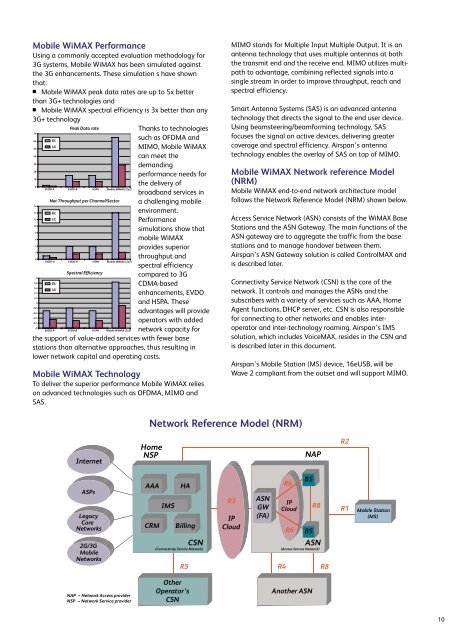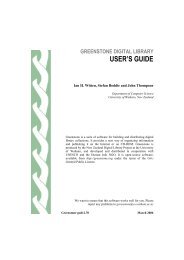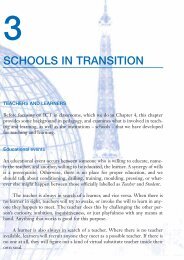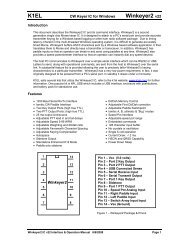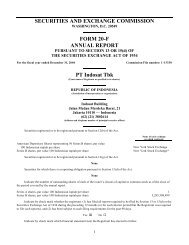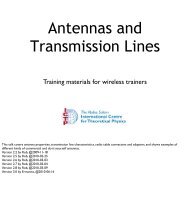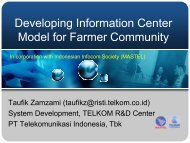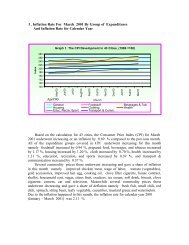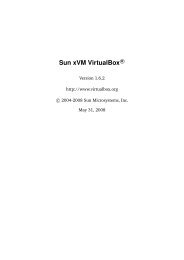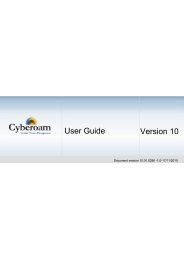WiMAXBrochure_RevE.pdf 2397KB Apr 16 2013 ... - mirror omadata
WiMAXBrochure_RevE.pdf 2397KB Apr 16 2013 ... - mirror omadata
WiMAXBrochure_RevE.pdf 2397KB Apr 16 2013 ... - mirror omadata
Create successful ePaper yourself
Turn your PDF publications into a flip-book with our unique Google optimized e-Paper software.
Mobile WiMAX Performance<br />
Using a commonly accepted evaluation methodology for<br />
3G systems, Mobile WiMAX has been simulated against<br />
the 3G enhancements. These simulation s have shown<br />
that:<br />
■ Mobile WiMAX peak data rates are up to 5x better<br />
than 3G+ technologies and<br />
■ Mobile WiMAX spectral efficiency is 3x better than any<br />
3G+ technology<br />
Peak Data rate<br />
Thanks to technologies<br />
70<br />
60<br />
50<br />
DL<br />
UL<br />
such as OFDMA and<br />
MIMO, Mobile WiMAX<br />
40<br />
can meet the<br />
30<br />
demanding<br />
20<br />
performance needs for<br />
10<br />
0<br />
EVDO-A EVDO-B HSPA Mobile WiMAX (2x2)<br />
the delivery of<br />
broadband services in<br />
Net Throughput per Channel/Sector a challenging mobile<br />
<strong>16</strong><br />
14 DL<br />
environment.<br />
12 UL<br />
Performance<br />
10<br />
simulations show that<br />
8<br />
6<br />
mobile WiMAX<br />
4<br />
provides superior<br />
2<br />
0<br />
EVDO-A EVDO-B HSPA Mobile WiMAX (2x2)<br />
throughput and<br />
spectral efficiency<br />
2<br />
1.8 DL<br />
Spectral Efficiency<br />
compared to 3G<br />
CDMA-based<br />
1.6<br />
1.4<br />
UL<br />
enhancements, EVDO<br />
1.2<br />
1<br />
and HSPA. These<br />
0.8<br />
0.6<br />
advantages will provide<br />
0.4<br />
0.2<br />
operators with added<br />
0<br />
EVDO-A EVDO-B HSPA Mobile WiMAX (2x2) network capacity for<br />
the support of value-added services with fewer base<br />
stations than alternative approaches, thus resulting in<br />
lower network capital and operating costs.<br />
Mobile WiMAX Technology<br />
To deliver the superior performance Mobile WiMAX relies<br />
on advanced technologies such as OFDMA, MIMO and<br />
SAS.<br />
Internet<br />
ASPs<br />
Legacy<br />
Core<br />
Networks<br />
2G/3G<br />
Mobile<br />
Networks<br />
NAP – Network Access provider<br />
NSP – Network Service provider<br />
Network Reference Model (NRM)<br />
Home<br />
NSP<br />
AAA<br />
IMS<br />
HA<br />
CRM Billing<br />
CSN<br />
(Connectivity Service Network)<br />
R5<br />
Other<br />
Operator’s<br />
CSN<br />
MIMO stands for Multiple Input Multiple Output. It is an<br />
antenna technology that uses multiple antennas at both<br />
the transmit end and the receive end. MIMO utilizes multipath<br />
to advantage, combining reflected signals into a<br />
single stream in order to improve throughput, reach and<br />
spectral efficiency.<br />
Smart Antenna Systems (SAS) is an advanced antenna<br />
technology that directs the signal to the end user device.<br />
Using beamsteering/beamforming technology, SAS<br />
focuses the signal on active devices, delivering greater<br />
coverage and spectral efficiency. Airspan’s antenna<br />
technology enables the overlay of SAS on top of MIMO.<br />
Mobile WiMAX Network reference Model<br />
(NRM)<br />
Mobile WiMAX end-to-end network architecture model<br />
follows the Network Reference Model (NRM) shown below.<br />
Access Service Network (ASN) consists of the WiMAX Base<br />
Stations and the ASN Gateway. The main functions of the<br />
ASN gateway are to aggregate the traffic from the base<br />
stations and to manage handover between them.<br />
Airspan’s ASN Gateway solution is called ControlMAX and<br />
is described later.<br />
Connectivity Service Network (CSN) is the core of the<br />
network. It controls and manages the ASNs and the<br />
subscribers with a variety of services such as AAA, Home<br />
Agent functions, DHCP server, etc. CSN is also responsible<br />
for connecting to other networks and enables interoperator<br />
and inter-technology roaming. Airspan’s IMS<br />
solution, which includes VoiceMAX, resides in the CSN and<br />
is described later in this document.<br />
Airspan’s Mobile Station (MS) device, <strong>16</strong>eUSB, will be<br />
Wave 2 compliant from the outset and will support MIMO.<br />
R3<br />
IP<br />
Cloud<br />
ASN<br />
GW<br />
(FA)<br />
ASN<br />
(Access Service Network)<br />
R4<br />
R6<br />
IP<br />
Cloud<br />
R6<br />
Another ASN<br />
NAP<br />
BS<br />
BS<br />
R8<br />
R8<br />
R2<br />
R1<br />
Mobile Station<br />
(MS)<br />
10


